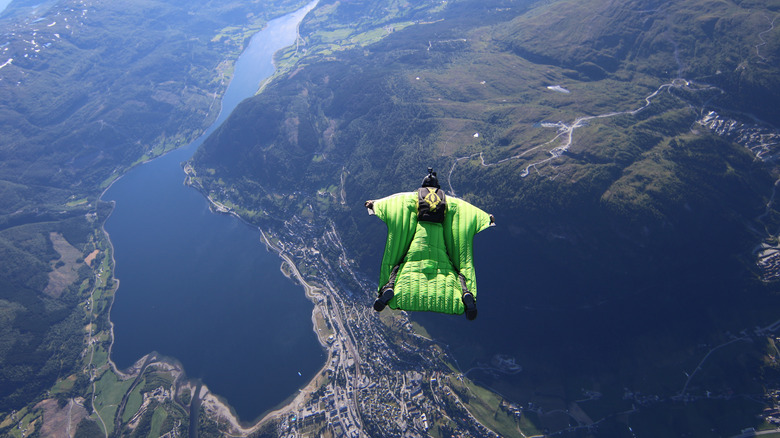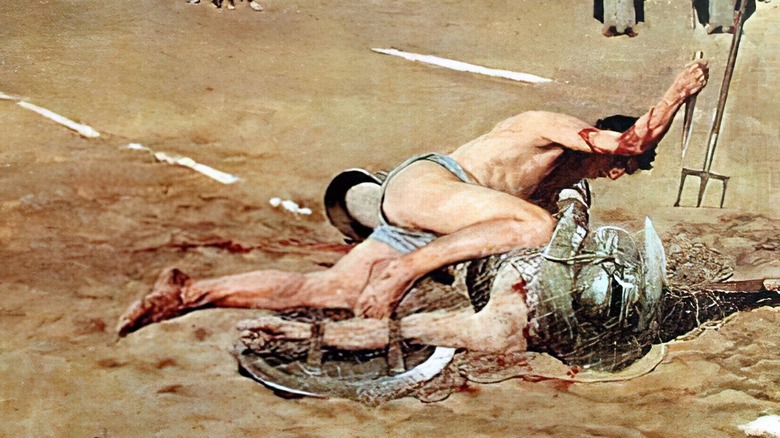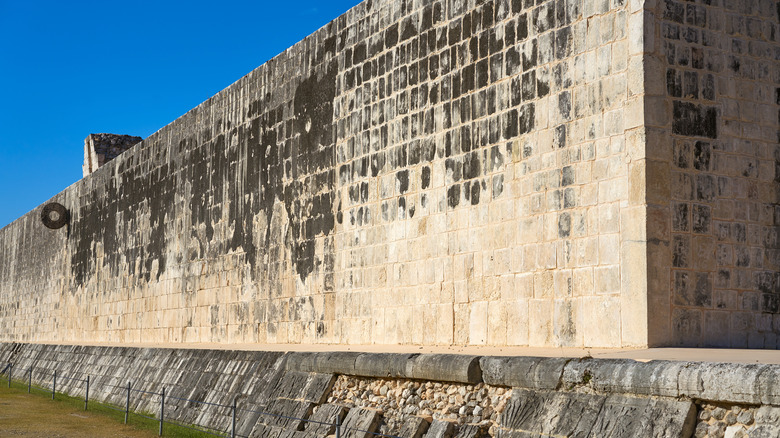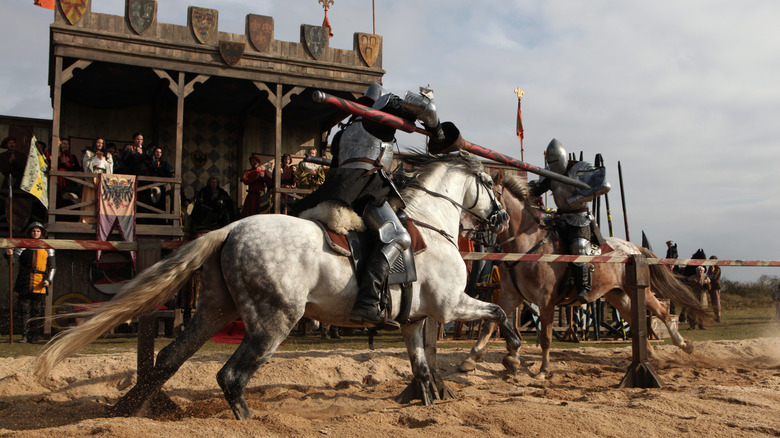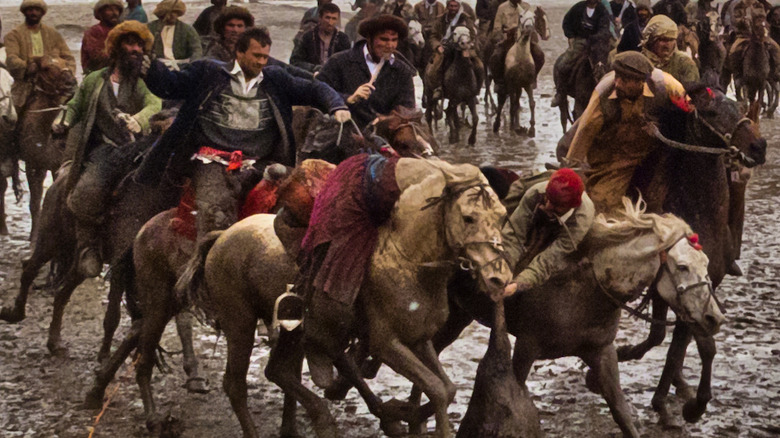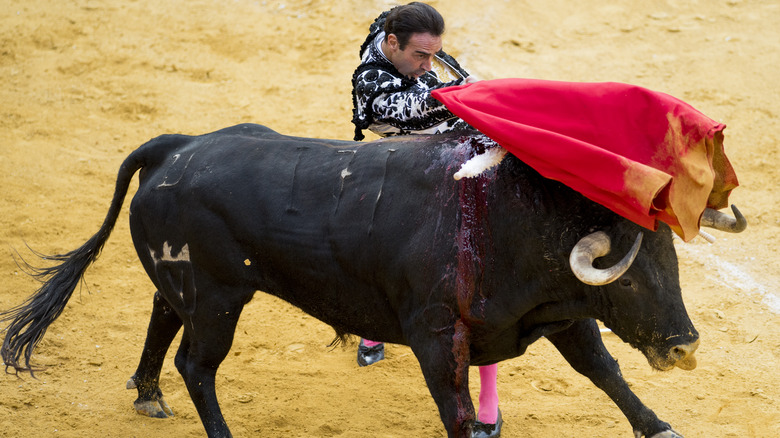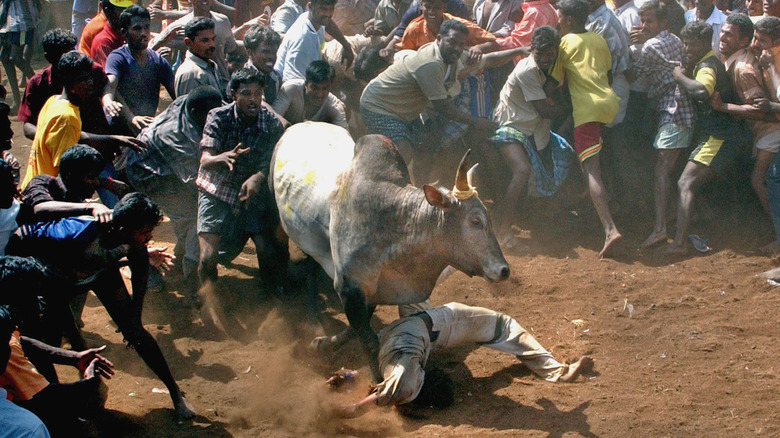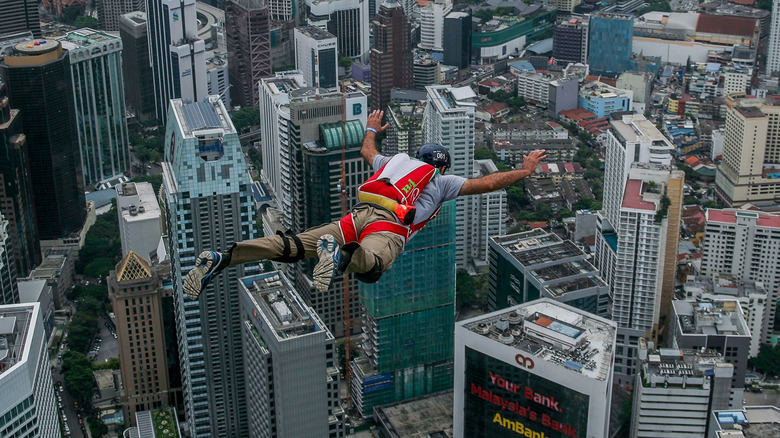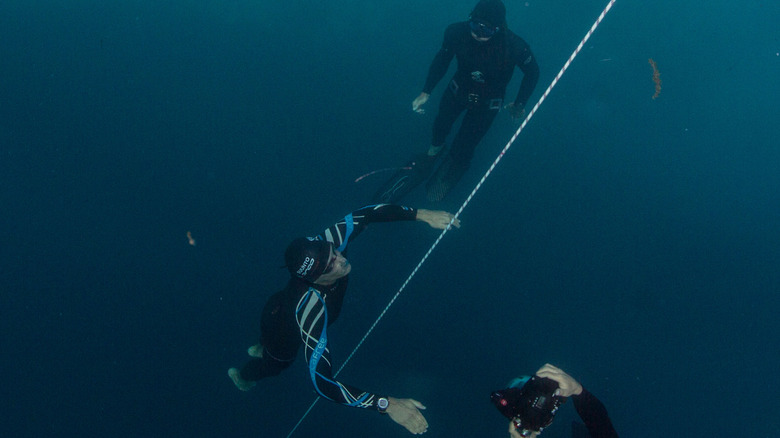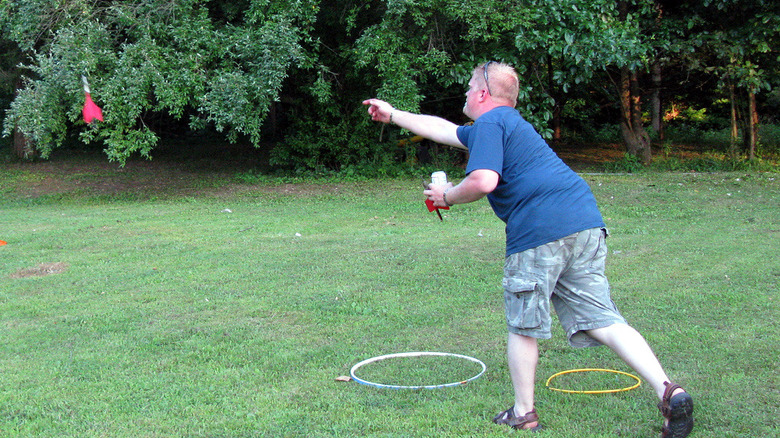The Most Dangerous Sports In The World
Every once in a while you hear about a freak death at a popular sporting event. For example, the 1971 death of wide receiver Chuck Hughes from a heart attack while playing for the Detroit Lions or the 1920 death of Ray Chapman, who was hit by a pitch while at bat for the Cleveland Indians. Professional hockey has countless examples of gruesome injuries including concussions, knocked teeth, broken bones, and pucks to the throat, but as reported by the Bleacher Report, only one hockey player has died from slamming his head on the ice — Bill Masterson, in 1961.
So what are the world's most dangerous sports? Let's take a look at some historical and traditional dangerous sports before shifting to modern competitions that you might want to avoid.
Fighting to the death is dangerous... duh
All Russell Crowe fans know about ancient history's most dangerous sport: Roman gladiatorial combat. The World History Encyclopedia explains that the ancient Etruscans developed these games before passing them on to the ancient Romans. The early Etruscan games had some religious significance, being viewed as death rites and a mode of sacrifice. However, by the games' heyday under the Romans from 105 BC to 404 AD there was barely anything religious about this wildly popular bloodsport.
The basic rules of gladiatorial combat are straightforward. Two individuals (usually slaves or prisoners of war) faced each other and fought to the death. There were four classes of warrior: Samnite, Thracian, Myrmillo, and Retiarius. What class you belonged to designated what kind of weapons and armor you were given. For example, the Retiarius fought with a net and trident while the Thracian was the most well-armored. This was meant to provide variety. The loser was given the option to appeal his death, and if the emperor was present, he decided the gladiator's fate. More often, spectators made the decision.
However, according to National Geographic, most trained gladiators were usually not killed. They were considered too valuable and their work was considered almost a performance. Gladiatorial combat was a big business, with over 100 schools across the empire and thousands of spectators coming to see events. Trained warriors certainly did better than the thousands of untrained fighters who died in the Colosseum, but this still tops out as antiquity's most dangerous sport.
The Mayans occasionally sacrificed ball players
What if you were a soccer player and knew that your life depended on the outcome of the match? This was the case for some in Mesoamerica, where pre-Columbian civilizations played a sport known as the ball game. According to National Geographic, most Mayan ruins include ball courts. It's thought that players wearing knee pads and protective belts hit small balls using only their elbows, knees, and hips. The objective was to get the ball through a stone hoop on the side of the court. This was difficult not just because players could not use their feet or hands, but also because the hoops were set high in the walls.
The ball game was essentially a combination of basketball and soccer, and for the most part was played as a leisure activity. However, it is thought that it also had religious and spiritual connections. World History Encyclopedia describes Mayan artifacts featuring scenes of losers being sacrificed, in some examples just the captain and in others the entire team.
It's unknown how often sacrifice occurred and there are theories that the winners were sacrificed (that being more honorable). The details might be murky, but it's clear the game was wildly popular — the Metropolitan Museum of Art reports that over 1,500 ball courts dating as far back as 1400 BC have been discovered. That being the case, it seems unlikely that someone was killed every time the ball game was played.
Jousting — people still do it
Horseback riding is dangerous. So is trying to skewer somebody with a long spear. Put the two together and you have jousting. The sport developed in the Middle Ages to test a knight's martial mettle. As explained by World History Encyclopedia, opponents would charge at each other with wooden lances in a field called the lists. In the late Middle Ages, opponents were separated by a wooden barrier called a tilt, which provided another name for the sport: tilting.
The original aim was to knock your opponent off his horse, although the game evolved to having the goal of hitting the center of the opponent's shield. By 1466, a number of rules had developed, making it a point-driven sport. The popularity of jousting declined rapidly after 1559, when King Henry II of France died in a joust with a splinter from a lance through his eye.
However, the glamor of knightly valor never really dies and there have been attempted revivals over the centuries. Today, people are still jousting. Organizations including the International Jousting Association offer guidance and rules for contemporary jousters. These organizations strive for authenticity, and, as the BBC reports, the injuries are authentic as well: broken bones, lacerations, concussions, and heatstroke from being encased in steel are some of the results of communing with a knightly past.
Getting your goat in buzkashi
What do you do with an eviscerated goat carcass? You put two teams on horseback and fight over it, of course. That is the essence of buzkashi, which as described by NPR is virtually a national pastime in Afghanistan.
Buzkashi means "goat grabbing" and was a sport invented as a means of training cavalry, possibly by the Mongols. The New York Times describes a typical game as including around 15 men on horseback, divided into teams. They are presented with a gutted and beheaded goat carcass that has been soaked in cold water to stiffen it. The horsemen slam, whip, grab, and grapple for the goat. When one gets it, he races down the field, circles a post, then races back 75 yards to drop the carcass onto a chalk circle and score a point. The game is played in rounds with each ending after a team gets a point and the person who scores a wad of cash. The other teams try to prevent this from happening by attacking the goat carrier, resulting in chaos. In the mayhem, it is common for horsemen to ride into the crowds since there is no defined boundary to the field. According to Stars and Stripes, critical injuries are common.
The winning team of a buzkashi game gets the goat, which is roasted and eaten. The constant pulling on the carcass makes it tender.
Bullfighting — of course it's dangerous
Sometimes described as more of an art than a sport, bullfighting is a long-standing and dangerous tradition. As Ernest Hemingway wrote in "Death in the Afternoon," "Bullfighting is the only art in which the artist is in danger of death." The origins of bullfighting are unclear but according to Britannica, forms of the sport date back to antiquity. Bullfighting as known today developed on the Iberian peninsula in the Middle Ages.
A traditional bullfight consists of six bulls against three fighters called matadors. The bulls, which can weigh as much as 1,600 pounds, are bred for aggression. First, the bull is weakened by picadores, who lance it. Then, the bull is darted by banderilleros, before the matador enters the ring and dances with the bull using a cape before dispatching it with a sword.
Fighting a large aggressive animal is obviously dangerous, and injuries are frequent. A 10-year study published in Trauma showed that over 9% of all bullfighters required some sort of emergency assistance, most often in the lower extremities where the bull's horns often gore the bullfighter. As for the bulls, NPR reports that a Spanish bullfight almost always ends with the matador killing the bull but that if the bull has behaved particularly well during the fight, it is "pardoned" and its life spared.
Jallikattu is like wrestling, but with a bull
Bullfighting may be dangerous, but what if you had to fight a bull with your bare hands? Jallikattu is a sport and ceremony popular in southern India. The Guardian reports that the rules are pretty straightforward: an agitated bull is released into a crowd of men, who then jump on the animal and try to hold onto its hump for either a certain length of time or a distance.
Outlook reports that the event is a part of annual festival called Pongal and that jallikattu celebrates the bravery of men. The sport is closely tied with Tamil identity. Hans India reports that it may date back to 400 BC, when women used it as a way to choose husbands and children would demonstrate their bravery by running up to the bull's horns and seizing a strap that contained coins. The Guardian reports that between 2010 and 2017, over 1,100 people died taking part in the sport.
Jallikattu has been subject to criticism from animal rights activists, and there is an ongoing battle to ban it. Unlike in bull fighting, the animals are rarely killed, but opponents see the sport as torment. The topic is politically charged, with jallikattu proponents claiming that banning the sport robs ethnic Tamils of their cultural heritage.
Jumping off cliffs results in numerous deaths
For most people, being told to go jump off a cliff would be an insult. However, there is a subset of extreme athletes who want to take the leap. According to National Geographic, these jumpers throw themselves off of buildings, antennae, spans, and earth (mountains) with only a single parachute preventing instant death. The four challenges provide the letters that make up the name BASE jumping — the most deadly modern sport.
Because these jumps are done at low altitudes with no reserve parachutes, the sport is up to eight times more deadly than skydiving, according to the journal Trauma. Research published in Wilderness and Environmental Medicine shows that over one in every hundred jumpers ends up dying as a result of the activity, and that there is more risk for those jumping off mountains and those using wingsuits.
Freediving is one breath to death
Many of us like to dive to the bottom of a pool and swim back up, but there are some athletes who take this type of game to the extreme. In freediving, the idea is that you compete to see how deep you can dive on one breath. AIDA, the international association that governs the sport, recognizes eight variants. The mildest is just holding your breath underwater, and the more extreme variations have you dive to a depth and then swim back up. The most extreme is No Limits Apnea, in which the diver can use any means to sink to a certain depth and then follow a guideline to the surface. They may use a balloon to help them rise.
Several divers have died trying to rise from extreme depths. One prominent death was the French freediver Audrey Mestre, who as reported by the New York Times as drowning while attempting to beat a world record.
The record for a No Limits Apnea dive was set by Herbert Nitsch of Austria in 2007 at 214 meters (702 feet). According to Deeper Blue, on a later dive, in 2012, Nitsch suffered from decompression sickness and was put in a coma for a week. After being wheelchair-bound, he eventually recovered and today is freediving again.
The world's most dangerous motorcycle race
One of the most thrilling and notorious of motorsports, the Isle of Man TT takes place over two weeks each summer. As described by the race's official site, it started in 1907, when visitors came to the Isle of Man to race motorbikes since the activity was banned in mainland Britain. The race takes place over 37 miles, with twists and turns on narrow roads through villages and full-throttle straightaways making it one of the most challenging motorcycle races in the world.
According to Guinness World Records, the fastest average speed on the course was set by Peter Hickman at over 135 miles per hour. Sports History Weekly reports that by 2019, 258 riders had died in the race, averaging over two per year. In 1970 alone, six riders died among the course's 200 turns.
The race is the most prestigious in the world with an avid fan base to keep it going. It is also the biggest event on the Isle of Man, bringing tourists and much-needed income to the community.
Water plus fast boats equals death
Powerboat racing is in a league of its own when it comes to dangerous sports. As described by Popular Mechanics, powerboat racers rev their vessels up to 140 miles an hour on straightaways and then take curves jammed up close to other racers, leading to fantastic flips and potential disasters.
Powerboat racing has all the dangers of land-based motor sports with one added element: the unpredictability of water. Michael Allweis, a former president of the American Powerboat Association has commented, "It takes courage and a cool hand to run with these people."
The Florida Keys News describes a 2017 incident in which a boat flipped, killing two of a party of four that included the boat owner, Joseph Sgro. Sgro owned assets in the powerboat manufacturer Outlimits, which he had bought when his friend and the founder of the company died in a powerboat accident a year earlier. The unpredictability of this type of racing was made clear when the investigating officer stated, "They could have snagged on something, the waves could have rolled the boat — there are a whole lot of variables we don't know."
Lawn darts — just a bad idea
What could be more idyllic than kids playing a game on a suburban lawn? How about if they're playing with weapons? Lawn darts, as Mashable describes, entails taking two weighted throwing darts and hurling them across a lawn to try to get them in a hoop. It's sort of like horseshoes except using a small hand javelin.
Lawn darts first went on the market in the 1950s, and, as one might expect, injuries were soon reported. According to Mentalfloss, it became so bad that the government required labeling to be placed on the packaging, recommending that the toy be kept away from children. This did not work, and the 1987 death of a 7-year-old girl by lawn darts pushed the Consumer Product Safety Commission to investigate. It found that over eight years, 6,100 people had gone to the emergency room due to lawn-dart injury and 81% of those cases involved children. Lawn darts were banned in 1988, although sets were not recalled. There is still an underground following of this dangerous game.
Soccer is the most dangerous sport — for spectators
So we've gone through some pretty dangerous sports so far — for the participants. But what about the spectators? There are occasional incidents of NASCAR race crashes flinging cars into the stands, as reported by Slate, and hundreds of spectators are injured each year by errant foul balls in baseball. But that's kid's stuff compared to the dangers you may face if you go to a soccer game.
It's unknown how many deaths occur each year at soccer games, but fighting, unsafe stadiums, and poor crowd control have all led to fatalities through the years. One of the worst incidents, as described by Britannica, occurred in 1989 at Hillsborough Stadium in England. Because of fears that rioting might break out among rival teams, the police separated the crowd for fans of respective teams to enter at difference entrances. This resulted in bottlenecks and then a mad crush as thousands rushed to their seats. Hundreds were injured and 96 lay dead by the time the stampede was over. The police initially blamed the fans, but it was soon found out there was a massive coverup.
